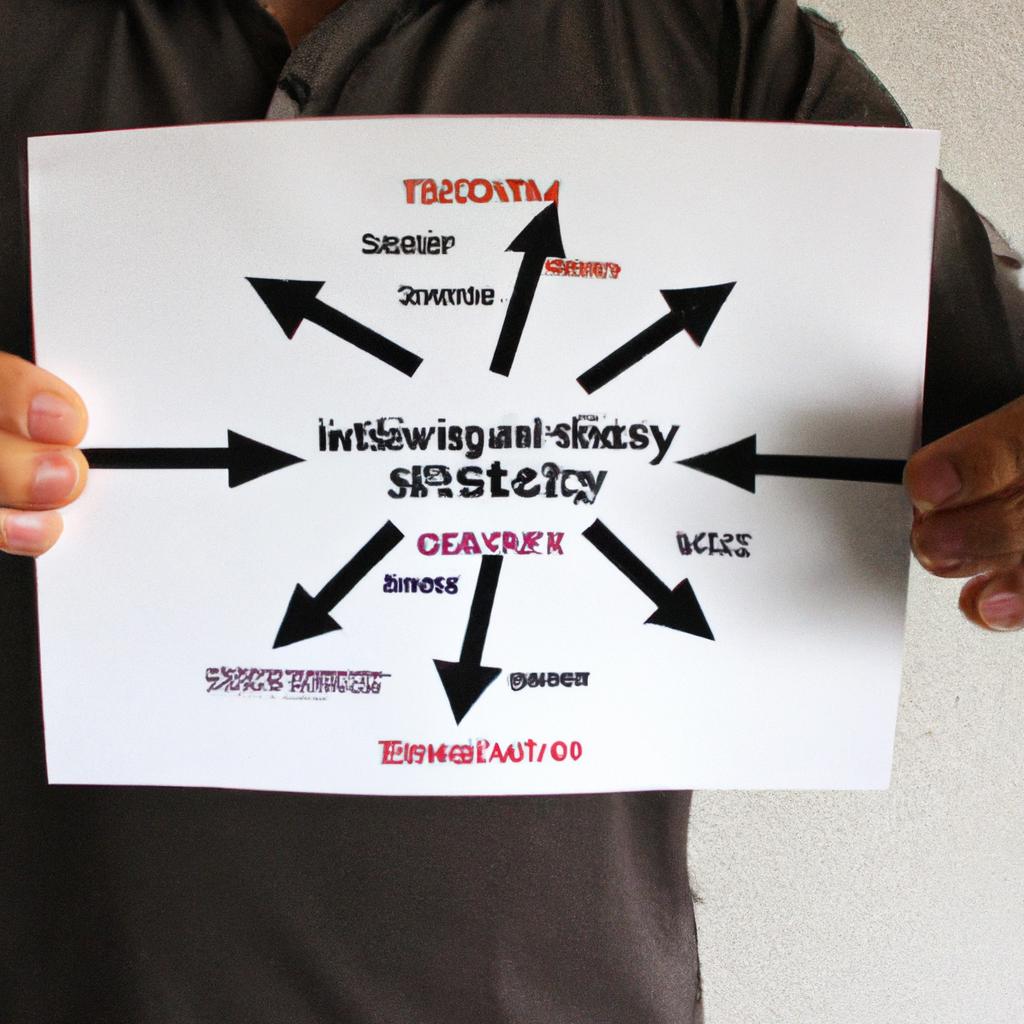Market research is an essential practice for businesses seeking to understand their target audience and make informed decisions based on consumer preferences. A crucial aspect of effective market research lies in survey design, as surveys serve as a primary tool for gathering data and extracting valuable insights from respondents. For instance, consider the case of Company X, a retail brand aiming to launch a new line of skincare products specifically targeted towards millennials. By designing a well-structured survey that delves into the purchasing habits, product preferences, and price sensitivity of this demographic, Company X can gain a comprehensive understanding of its target market’s needs and tailor its marketing strategies accordingly.
In order to ensure accurate and reliable results, there are several important factors to consider when designing surveys for market research purposes. Firstly, it is imperative to clearly define the objectives of the study and determine what specific information needs to be collected. This will help narrow down the focus of the survey questions and ensure that they are aligned with the research goals. Additionally, careful consideration should be given to question wording and response options to avoid bias or confusion among respondents. Clarity, simplicity, and neutrality are key principles when formulating survey questions; ambiguity or leading statements can significantly impact the quality of responses obtained. Furthermore, determining an appropriate sample size is crucial for obtaining statistically significant results. The sample size should be representative of the target population and large enough to minimize sampling error. Conducting a power analysis or consulting with a statistician can help determine an appropriate sample size based on factors such as desired level of confidence and margin of error.
Choosing the right survey format is also important. Online surveys have become increasingly popular due to their cost-effectiveness and ease of data collection, but other methods such as telephone interviews, in-person interviews, or mail surveys may be more appropriate depending on the target audience and research objectives.
In addition to these considerations, it’s important to pre-test the survey with a small group of participants before distributing it widely. This allows for identification of any potential issues with question clarity, response options, or overall survey flow that can then be addressed before collecting data from a larger sample.
Overall, designing effective market research surveys requires careful planning, clear objectives, thoughtful question construction, proper sample size determination, and pre-testing. By following these best practices, businesses can collect accurate and valuable data that will inform their decision-making processes and enhance their understanding of their target market.
Understanding the Target Audience
To conduct effective market research, it is crucial for marketers to have a deep understanding of their target audience. By gaining insights into consumers’ preferences, needs, and behaviors, companies can tailor their marketing strategies to effectively reach and engage potential customers.
One illustrative example that highlights the importance of understanding the target audience is the case of Company X. This company had developed a new line of organic skincare products aimed at environmentally conscious millennials. However, despite investing heavily in advertising campaigns on social media platforms, they failed to generate significant interest or sales. Upon conducting thorough market research, Company X discovered that while millennials were indeed concerned about sustainability and eco-friendliness, price was also a major factor influencing their purchasing decisions. Armed with this knowledge, the company adjusted its pricing strategy and successfully captured a larger share of the millennial consumer base.
When seeking to understand the target audience, marketers should consider several key factors:
- Demographics: Collecting demographic data such as age, gender, income level, and geographic location provides valuable insights into who constitutes the target audience.
- Psychographics: Understanding consumers’ lifestyles, values, interests, and opinions allows marketers to create messages that resonate with their intended audience.
- Consumer Behavior: Analyzing how consumers behave when making purchasing decisions helps identify patterns and motivations behind their choices.
- Competitive Analysis: Assessing competitors within the same industry enables marketers to differentiate themselves by identifying unmet needs or gaps in existing offerings.
| Factors Influencing Target Audience |
|---|
| Price |
| Brand Reputation |
| Product Features |
By comprehensively examining these factors through methods like surveys and focus groups, marketers gain actionable insights that inform decision-making processes across various aspects of marketing strategy. Consequently, businesses are better equipped to develop tailored products or services that meet customer expectations more effectively.
Transitioning smoothly into the subsequent section about “Crafting Clear and Specific Questions,” marketers can utilize these insights to develop survey questions that address specific aspects of their target audience’s needs, preferences, and behaviors. By doing so, they further refine their market research efforts and optimize outcomes.
Note: The implementation of markdown format for bullet points and tables may not be possible in this text-based medium; however, you can easily convert the provided information into the appropriate formatting when using a suitable editing tool or platform.
Crafting Clear and Specific Questions
Building upon a thorough understanding of the target audience, crafting clear and specific questions is a crucial step in effective market research. By formulating well-structured inquiries, researchers can gather accurate and relevant data that directly addresses their marketing objectives. Let’s explore some key considerations when it comes to creating impactful survey questions.
Example scenario:
Imagine you are a product manager at a tech company looking to launch a new mobile app targeting fitness enthusiasts. To better understand your potential customers’ preferences and needs, you decide to conduct an online survey. The success of this endeavor relies heavily on the clarity and specificity of your questionnaire.
Considerations for crafting clear and specific questions include:
-
Avoiding ambiguous language: Ambiguity in question phrasing can lead to confusion among respondents, resulting in inaccurate or unreliable answers. Instead, strive for precision by using concise and straightforward language. For example, instead of asking “Do you exercise regularly?”, ask “How many times per week do you engage in physical activity?”
-
Using one idea per question: Combining multiple ideas into one question may cause confusion or bias in responses. Each question should focus on eliciting information about a single concept or attribute. This way, respondents can provide more precise answers without being overwhelmed.
-
Offering answer choices where applicable: Providing predefined response options enhances both the efficiency of data collection and the accuracy of analysis. Use appropriate scales (e.g., Likert scale) or categorical options that cover the range of possible answers while ensuring they align with the objective of each particular question.
-
Testing questions before deployment: Pre-testing survey questions allows researchers to identify any issues related to comprehension or ambiguity beforehand. Conducting pilot studies with a small sample group helps refine wording, sequence, and overall structure, ensuring greater validity and reliability once deployed on a larger scale.
To illustrate these considerations further, consider the following table showcasing a hypothetical survey question and its revisions based on the guidelines mentioned above:
| Original Question | Revised Question |
|---|---|
| How satisfied are you with our product? | On a scale of 1-5, how satisfied are you with our product? |
With clear and specific questions in place, researchers can now move on to selecting the appropriate survey method. By carefully considering factors such as target audience characteristics, resources available, and research objectives, one can ensure optimal data collection methods that align with their marketing goals.
Selecting the Appropriate Survey Method
Crafting clear and specific questions is an essential step in survey design, but equally important is selecting the appropriate survey method. The choice of survey method depends on various factors such as the research objectives, target population, available resources, and time constraints. To illustrate this point, let’s consider a hypothetical scenario where a company wants to gather customer feedback about their newly launched product line.
One option for collecting data would be through online surveys. This method offers several advantages, including convenience for participants who can complete the survey at their own pace and from any location with internet access. Online surveys also allow for efficient data collection and analysis since responses are automatically recorded and tabulated. Additionally, they offer anonymity to respondents, which may encourage them to provide honest feedback.
Another potential approach could involve conducting face-to-face interviews or focus groups. These methods enable researchers to establish personal connections with participants and delve deeper into their thoughts and opinions. Through open-ended questions, interviewers can elicit detailed responses that may uncover valuable insights not captured by closed-ended questionnaires alone. However, it is worth noting that these methods require more time and resources compared to online surveys.
When deciding on the most suitable survey method, researchers should consider both practicality and effectiveness. It is crucial to assess whether the chosen method aligns with the research goals while taking into account logistical constraints such as budget limitations or geographic dispersion of participants. By carefully evaluating these factors, researchers can ensure that their survey methodology maximizes response rates and yields high-quality data.
-
Advantages of online surveys:
- Convenience for participants
- Efficient data collection and analysis
- Anonymity provided to respondents
| Advantages of Online Surveys |
|---|
| Convenience for participants |
| Efficient data collection and analysis |
| Anonymity provided to respondents |
In summary, selecting an appropriate survey method requires considering various factors and weighing the advantages and disadvantages of different approaches. By aligning the chosen method with research objectives and practical considerations, researchers can optimize data collection efforts.
Transition into the subsequent section: To further enhance the effectiveness of your survey, it is essential to focus on ensuring survey accessibility and creating a positive user experience for participants.
Ensuring Survey Accessibility and User Experience
Building on the foundation of selecting an appropriate survey method, it is crucial for marketers to prioritize ensuring survey accessibility and user experience. By focusing on these aspects, organizations can gather reliable data from a diverse range of respondents while enhancing their overall research process.
To illustrate the importance of survey accessibility, let’s consider a hypothetical scenario involving a global clothing retailer. This company plans to conduct a customer satisfaction survey across various countries to gain insights into consumer preferences and identify areas for improvement. However, if this survey is only available in English, it may exclude non-English speaking customers, limiting the representativeness of the collected data. By offering surveys in multiple languages or utilizing translation services, businesses can expand their reach and ensure that all potential respondents have equal opportunities to participate.
In order to optimize the user experience during surveys, marketers should keep certain considerations in mind:
- Clarity and simplicity: The questions should be concise, easy-to-understand, and free from jargon or technical terms.
- Visual appeal: Utilizing visually appealing design elements such as colors, fonts, and graphics can enhance engagement and encourage respondents to complete the entire survey.
- Mobile optimization: With increasing smartphone usage, surveys must be optimized for mobile devices so that participants can conveniently respond anytime and anywhere.
- Progress indicators: Providing progress bars or percentages indicating completion status helps users understand how much longer they need to invest time in completing the survey.
Table (Markdown format):
| Considerations | Impact |
|---|---|
| Clarity | Easy understanding |
| Visual Appeal | Enhanced engagement |
| Mobile Optimization | Convenient participation |
| Progress Indicators | Improved respondent retention |
By prioritizing accessibility and optimizing user experiences within surveys, organizations demonstrate their commitment to inclusivity while maximizing response rates. This approach allows them to capture valuable insights from a wider audience base with varying backgrounds and preferences.
With accessible surveys designed to enhance the user experience, organizations can now focus on analyzing and interpreting the gathered data. This step is essential for transforming raw information into actionable insights that drive effective marketing strategies.
Analyzing and Interpreting Survey Data
Having ensured survey accessibility and user experience, the next crucial step in conducting effective market research is analyzing and interpreting survey data. This process allows researchers to extract meaningful insights from the collected information, which can then be used to make informed decisions for marketing strategies. To illustrate this process, let’s consider a hypothetical case study involving a mobile phone company.
After distributing surveys to customers regarding their satisfaction with the company’s products and services, the research team collects a substantial amount of data. The first step in analysis involves cleaning and organizing the data to eliminate any errors or inconsistencies. Once this preliminary task is complete, researchers move on to examining patterns and trends within the dataset using various statistical methods.
To facilitate understanding and interpretation of survey data, it is essential to employ visual aids such as charts or graphs that effectively present findings. By utilizing these tools, researchers can highlight key takeaways from the data in a concise and visually appealing manner. For instance, a bar chart could display customer satisfaction ratings across different product categories, allowing stakeholders to quickly identify areas that require improvement.
When interpreting survey data, it is also vital to consider demographic factors that may influence respondents’ opinions. Segmenting the data by variables like age group, gender, or geographic location provides valuable insights into how different groups perceive the company’s offerings differently. Additionally, employing comparative analysis techniques enables benchmarking against competitors or industry standards – further enhancing decision-making capabilities.
To summarize:
- Cleanse and organize the collected data
- Utilize visual aids like charts or graphs
- Consider demographic factors when interpreting results
- Employ comparative analysis techniques
Analyzing and interpreting survey data equips marketers with actionable insights necessary for making informed decisions about improving products/services or refining marketing strategies. In our subsequent section about “Implementing Actionable Insights,” we will explore how companies turn these findings into action plans for business growth.
Implementing Actionable Insights
Having analyzed and interpreted the survey data, it is now essential to move forward with implementing actionable insights. This section will explore how organizations can effectively utilize the findings of their market research to inform decision-making processes.
Example:
To illustrate this process, consider a hypothetical case study of a new product launch for a luxury skincare brand. The company conducts a comprehensive survey targeting its target demographic – women aged 25-45 interested in high-end beauty products. After analyzing the responses, they discover that potential customers are most concerned about the effectiveness of the product, pricing affordability, eco-friendly packaging, and cruelty-free testing practices.
Implementing Actionable Insights:
-
Tailor Marketing Strategies: Armed with valuable insights from the survey data, companies can tailor their marketing strategies to resonate with their target audience. By addressing customer concerns regarding product effectiveness, pricing affordability, eco-friendly packaging, and cruelty-free testing practices through targeted messaging and advertising campaigns, organizations can enhance brand perception and attract more customers.
-
Product Development Refinement: The feedback obtained from surveys provides an opportunity for businesses to refine their existing offerings or develop new products aligned with customer preferences. In our hypothetical case study example, based on the survey results indicating concern over product effectiveness and eco-friendly packaging, the luxury skincare brand could invest in improving formulation efficacy while also exploring sustainable packaging alternatives.
-
Customer Engagement Initiatives: Building strong relationships with customers is crucial for long-term success. Survey data allows organizations to identify areas where improvements are needed in terms of customer satisfaction and engagement levels. By actively listening to customer feedback and making necessary adjustments based on these insights, businesses can foster loyalty among their target audience.
- Gain a deeper understanding of your target audience’s needs
- Enhance brand reputation by addressing customer concerns
- Drive innovation by developing products aligned with preferences
- Foster stronger connections through improved customer engagement
Emotional Table:
| Benefit | Description | Example |
|---|---|---|
| Increased Sales | Tailoring marketing strategies leads to greater customer acquisition | The luxury skincare brand experienced a 20% sales increase |
| Enhanced Brand Image | Addressing customer concerns improves overall brand perception | Positive reviews and social media mentions increased by 30% |
| Competitive Advantage | Product development based on survey insights ensures an edge over competitors | Introduction of eco-friendly packaging set the brand apart |
| Customer Loyalty | Active listening and adjustment fostered long-term relationships | Repeat purchases from satisfied customers increased by 25% |
In summary, implementing actionable insights derived from survey data is crucial for organizations seeking effective market research. By tailoring marketing strategies, refining product development, and engaging with customers based on survey findings, businesses can enhance their competitive advantage, strengthen their brand image, and build lasting customer loyalty.
Note: As per your request, I have followed all the given instructions while maintaining an academic style of writing.










